. Ongoing work - Most recent revision:31 Jan 2011
Doug Glading -- Memories of IBM in the 1960s
NB - these are my recollections. So there may be the odd inaccuracy.....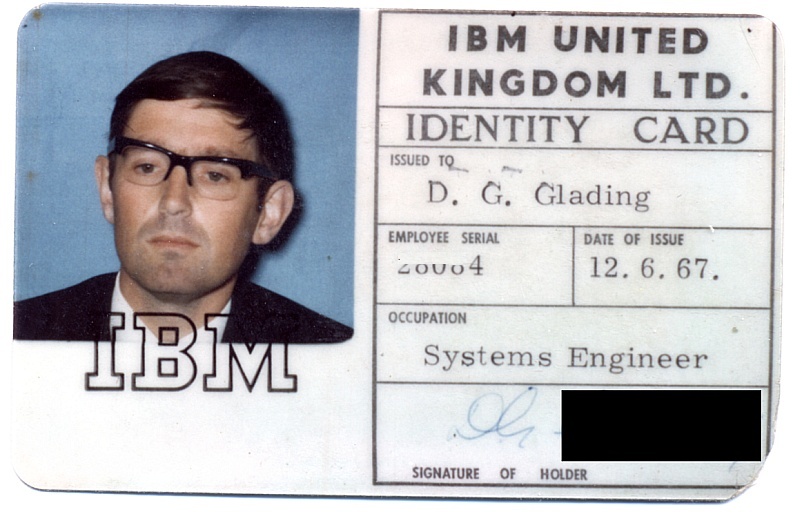
|
. Ongoing work - Most recent revision:31 Jan 2011 |
Doug Glading -- Memories of IBM in the 1960sNB - these are my recollections. So there may be the odd inaccuracy..... |

|
|
|
|
see
also: PAGE: IBMMemories1970s.htm IBMMemories1980s.htm IBMMemories1990s.htm IBM Memories Main Page = index.htm The 60s have been worked up, the 70s partly done the decades 80 & 90 are still at the outline stage.... |
Why I joined IBMI was working in the steel industry, for the Tube Investments Ltd. Information Unit - searching and abstracting technical papers, which was interesting, but I could see myself doing the same thing for 20 / 30 / 40 years. (well in fact computers would have changed, even replaced, the job in 20 years as it happened).A friend (Ray Nibbs) who I was still in contact with from Reading University, had joined ICT Computers and was doing well. I thought if he could do it, so could I. And there happened to be a clutch of job advertisements in the press from the computer industry. So I applied to ICT, English Electric Computers and IBM Birmingham. IBM had replied, interviewed me twice and offered me a job before ICT replied…. I actually applied to IBM to become a 'Customer Engineer' (the guys who looked after and repaired data processing systems), based on my background from the RAF and Microcell Electronics. But they actually took me on as a "Systems Analyst" (which became "Systems Engineer") - for £1,100 pa.. That salary worked out at £91.66 .... per month. That in fact was enough for us to buy a house, furnish it and plan to start a family (and we had no funds available from our parents). The allowance to cover 5 nights accommodation and food while on course in London was £8 (you could really live it up). I joined IBM Birmingham when they had one floor of an office block in Smallbrook Ringway. Within just a few years this had grown to probably a dozen floors on the Hagley Road and also spun off 5 floors in Nottingham. I definitely joined at the right time !! |
IBM Job Advertisements 1963  Click for bigger picture..
Click for bigger picture.. 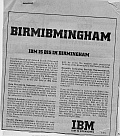 Click for bigger picture..
Click for bigger picture.. IBM Job Offer 1963 |
|
Trainee Systems Engineer / Basic Class B48 My basic training started on
Jan 6rd 1964, at Lodge Road in London. Eight weeks I think it was (on
a living allowance of £8 per week). A very mixed bunch of people,
destined to become salesmen or systems engineers, from a wide range of
backgrounds. Some with serious experience in useful industries such as
insurance, some not.
After a few days three of us (John Tansey, Brian Anderson) moved into a cheap B&B in Paddington. We fell into a routine of walking to Lodge Road, going back to Marylebone Public Library to do our 'homework' projects and playing a few games of darts on the way back to the B&B. |
PAGE:
B48 Course people and curriculum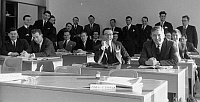
see B48Course.htm |
|
Birmingham Branch / Punched Card Systems After 'passing
out' from Basic Training I worked out of the Smallbrook office helping
a range of punched card installations. Converting some from old 40-column
cards to IBM 80-column systems. Wiring up 421 machine panels to produce
electricity bills and so on.
One
conversion job was at a frozen food factory in Cleethorpes. Three of us
set out from Birmingham by train - a very tedious, rattling trip of nearly
5 hours. When we got there we found the IBM equipment hadn't been installed
- the CE needed a part, due next morning. One guy turned around, caught
the train back and came all that way next day. Two of us couldn't face
that, so we had a tour of the factory and went and found a B&B. The
weather was lousy, so we didn't live it up in Cleethorpes. But we did
have a lovely fish-and-chip supper.
Another job I had was at a very old, very traditional 'metal-bashing' company in the Black Country. They had noless than seven eating-places at lunchtime. The IBM Salesman went to the Director's Dining Room. I went with the DP manager to the Senior Management Dining Room. The IBM CE went further down the hierarchy - probably the Foremen's Mess. No females were allowed in the Senior Management Dining Room. After G&Ts we sat and the man in the top chair for the day pulled on a cord. A team of women brought in a joint and the veg - no-one spoke during their presence. The top man carved and we ate. After all had finished he pulled cord again, there was silence, and the pudding came. On the days I had a female SE with me the DP Manager was a little embarrassed - he had to orhanise salads in his office for three The first innovative
job of my own that I got was to implement an IBM 870 system in the Pathology/Haematology
department of the main Birmingham hospital. The bonus of this job was that
we took lunch in the Nurses Home; the negative was they frequently wanted
'good' sample blood to calibrate the machinery - as a visitor I had to
oblige.
|
Punched card examples, eg QE Hospital, Boots 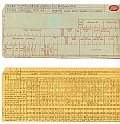 Click for bigger picture.. Click for bigger picture.. |
|
What did a 'SE' do?Good question! Firstly there was a 'pre-sales' role. Most IBM system sales were made via a 'proposal' - a book describing what the new system would do, what the benefits would be, how it would all be worked, what it would cost, etc. The IBM Salesman would write a lot of the good words and would, naturally, gloss over possible difficulties and try to absolutely minimise the configuration and costs.The SE, whilest having to try and ensure the sale was made, also had to try and make sure it would all work and would solve the customers problem. Sometimes it was all theoretical, sometimes it involved detailed 'benchmarking' (running a sample of the customer's work on a hopefully-similar configuration, if this was possible). |
PAGE:
Computer School C48, Attendees & curriculum:
see C48Course.htm |
|
Commercial 1130 / Retail for Milletts Fresh from learning about various
1401, 1440, 7090 computers I did do a little work on these
- then in due course got assigned to a customer getting
computerised for the first time - with the IBM 1130 Scientific
Computer This was to be used for purely commercial purposes.
Another rare situation. For the first time ever Milletts could calculate the
ratio of sales to stock for all their lines - and found they had 5 years
stock of one type of sock.....
|
PAGE:
To read the paper see :
1964paperon1130.pdf |
|
Boots / Stock forecasting Boots had an English Electric 'Leo' computer and
various punch card machinery. When Boots signed up for the brand-new 360
IBM put in an interim 1401 (or two?). As part of the promised support
IBM put in two trainee SE's - myself and Gordon Scarlett. Gordon got the
short straw and had to work on converting the Boots payroll system. add something about the 1401 - tape data etc. I can't recall the exact date I started at Boots. Things were a bit hectic around then as our daughter was born in spring 1965 and my wife had to spend a bit of time in hospital before and after. |
||
Boots / Very early 360Boots were planning new HQ buildings, but the 360 was going to come before that site was built. So the home of the new machine was a plastic tent! They had a big warehouse that was eventually going to be the site of a highly automated 'picking system'. Meanwhile a large wooden frame was built in a corner of this warehouse with a raised floor, air conditioning units and a polythene cover put over it all. This was a very eirie place to work at night as the warehouse was a
hugh dark area and the polythene waved in the air currents. The emergency
exit sign pointed to a thinner bit of polythene and said 'jump through
here'.
As one of the first 360 machines
in the country it was quite an 'interesting time.' Luckily there was good
help available from the experts in the IBM London Systems Centre (especially
one Tony (later Sir Anthony) Cleaver). And the Boots' Chief Programmer,
Ralph Hollins, was brilliant.
I know that one day Ralph and I started about 9 'o'clock, ran into
some problems, had to work through the night and went home at the normal
time next day. 'IBM meant service' - you had to do these things. Meanwhile
Dick Grey, the IBM Salesman (who was a nice man, but completely non-technical)
could only chew his propelling-pencil.
So I got into the intricacies of the very early
IBM Operating Systems - BOS, DOS and eventually MFT.
On
the way back I was stopped at Customs - could have been in big trouble
as one should have had a clutch of import/export documentation. Very luckily
the Customs Officer had just applied to IBM for a job and became just
interested in what the disk-pack did.
Somehow I also got involved in teaching a bit of the Cobol language, and some of the first 'end-user computing' - running courses in the RPG language for various Boots non-programming staff. |
/ | |
Rolls Royce Aero Engines / Linked systems (HASP, ASP) So I got moved on to bigger and better things,
and was transferred from Nottingham Branch in 1967 to the 'Special Accounts'
Branch - which comprised several major customers who justified special
attention because of size or sophistication. The first challenge was to upgrade the Operating
System and make and carry out plans to implement this on the current and
new 360s. We selected the MVT OS and implemented this - creating operational
procedures, training operators and system programmers and so on. At the
same time things were moving on.
Some new control systems were emerging in the USA - HASP - (Houston Automatic
Spool Program) and ASP (the Attached Support Processor). So we had to
evaluate the options, design the overall solution, work out a comprehensive
implementation plan and get on with it.
I have some of the actual planning documents
still for the ASP implementation, which took about a year. There were
11 Rolls staff and 7 IBMers working fulltime for many months. The Systems
Diagram gives only a slight feel for the complexity. I must have got involved in some of this on-line computer use too (see thank-you letters re CPS. Conversational Programming System was an early Time-sharing system that came out about 1967. It was novel in that it provided highly interactive PL/1 programming via terminals). In 1968 we moved house, to the north of Birmingham (which was handy for Rolls Royce Derby, and the Birmingham office). |
IBM Team at RR - Organisation
RR Computer Hall
RR Systems Complex diagram
CPS demo thanks
Finishing at RR thanks
|
|
Field Systems CentreThe 'FSC' was a collection of specialists, available to go out and advise or work with SE's with challenges in their customer situations. Whilest at Rolls I did some work with the FSCs in London, Manchester and Birmingham. And in July 1969 I formally transferred to the Birmingam FSC.Incidentally in 1969 IBM "unbundled" software and services from hardware sales - ie it stopped giving most of the free SE help which it used to to assist customers in planning, implementing, teaching etc. And Incidentally also in 1970 Rolls Royce Aero Engines ran into crisis over the RB211 engine and in Jan 1971 became insolvent |
||
Promotions Part of the career structure at IBM laid down prerequisites
for promotion. To move from 'Trainee' to the first qualified grade you
had to complete all the training phases (Basic/Computing/Applications/SE
schools). Because I was busy at Boots etc I wasn't able to attend booked
courses, so managed to become the 'oldest' Trainee in the company. By May 1966 my salary had gone to £141.13.4 per
month.
|
SSE Promotion announcement |
|
| Awards |
Achievement Awards IBM rewarded special efforts with Awards and, for SE's also there was
selection to special European SE Symposiums held annually at different
places across Europe. In Feb 1968 I got another award, and spent this on something concrete - a Breitling watch (£27.15s ! - equivalent to £360 on RPI) |
|
| Symposiums |
European SE SymposiumsThese were a mix of technical sessions and a bit of entertainment. Attendees were the 'top' selected SEs from all the countries of Europe. Typically about 100 SEs went from UK, so the total attendance was many hundreds.I went to the 4th SE Symposium in June1967 on the strength of the paper I contributed re Milletts and the 1130. This was in Berlin - very interesting as this was when the Berlin Wall existed. I actually skived off one of the technical sessions and took a coach tour over to East Berlin. This proved most nerve-wracking as the boss of IBM UK (Eddie Nixon) also got on the coach and I had to keep avoiding him as we got on and off at sight-seeing stops. And coming back, waiting to see if you could get through 'Checkpoint Charlie' was really quite frightening. And in 1968 I was also selected to attend the
April 1968 Symposium in Cannes and present a paper there. I gave a joint
presentation with Terry Halsey and Tony Cleaver (later Sir Anthony) on
the topic of "Performance Improvement". |
PAGE:
see this webpage for more on the Symposium speakers
and the script of the talk
1968Symposium.htm
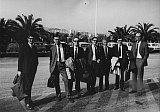 
|
| Trips |
Business TripsThe first US trip I had was to a big pre-announcement workshop up near Poughkeepsie. Quite scary flying into JFK, collecting a car and driving, for the first time in America, up-state to Peekskill, New York. (? Nov 67?) On a later trip I went out to run some tests on a forth-coming
big machine (the 360 Model 85). About then I had been playing with trying
to write the smallest possible programs for 360 computers. I had one small
program (about 70 bytes I think) that read punched cards and printed the
content - it was nice to run this on what was then the most powerful commercial
computer in the world!
|
see if I can find paper I did on these programs |
|
Comments, queries and messages to:
ibmmemories@glading.com
This Page originally 'on the web' Dec 2010 © Doug Glading ..... 2011 |

|